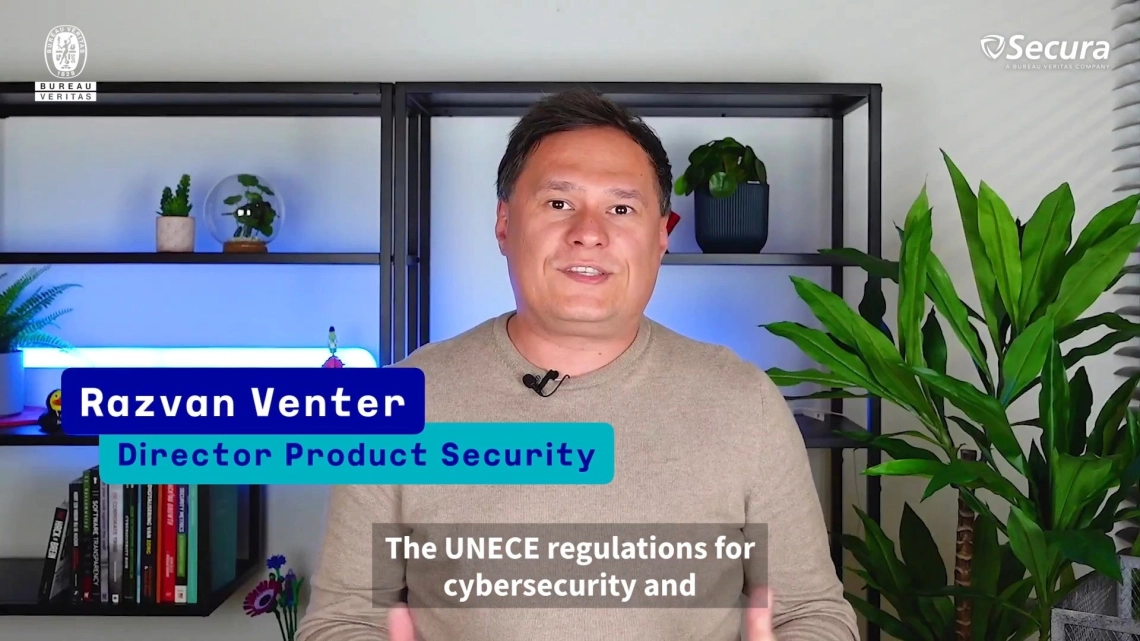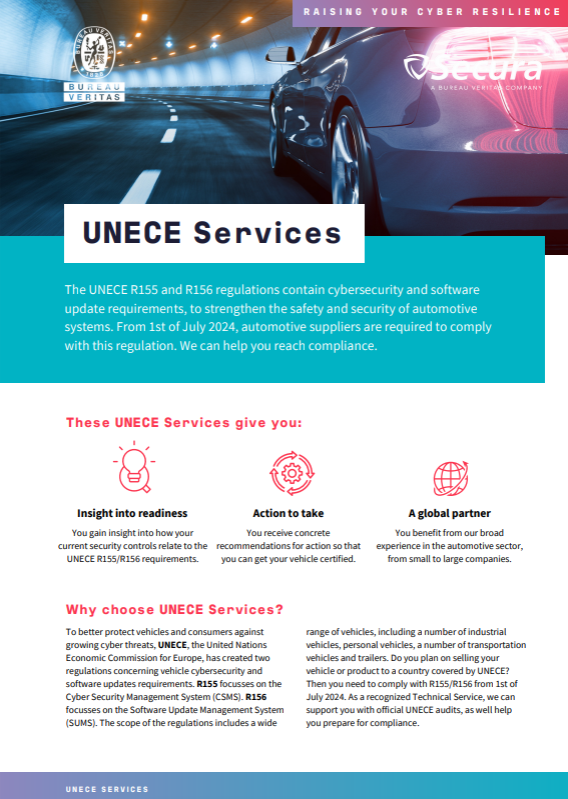How to reach UNECE R155/R156 compliance
From the 1st of July 2024 vehicle manufacturers must comply with UNECE R155/R156 regulations. Let us help you reach compliance.
... > Automotive > UNECE R155/R156 Compliance
Reaching UNECE R155/R156 compliance
The UNECE R155 and R156 regulations establish cybersecurity and software update requirements, to strengthen the safety and security of automotive systems. UNECE compliance:
- Simplifies the regulatory process for manufacturers looking to sell their products in multiple countries.
- Demonstrates your commitment to producing safe and secure vehicles, boosting consumer confidence and ultimately promoting the transition to more sustainable transportation options.
- Promotes a collaborative approach, for instance knowledge sharing and the exchange of best practices, leading to a more comprehensive understanding of electric and hybrid vehicle safety.
The UNECE R155 and R156 regulations are complex. We have the expertise to help you ensure your automotive products meet these important international standards.


Gain insight into gaps

Find out which action to take

Get your vehicle certified
Your challenges
The biggest challenges the automotive world faces with respect to the R155 and R156 regulations are:
- Getting a clear understanding of the requirements in R155 and R156
- Adapting existing processes to meet the requirements in R155 and R156
- Drafting and implementing new processes where needed
- Relying on a partner to efficiently support with advice
- Getting the vehicles certified on time, to ensure smooth market access

Razvan Venter
Director Product Security
Secura
We still see many automotive companies struggle with the demands of UNECE, especially the smaller companies. We can help you in the whole compliance journey, from training all the way to certification.
How we can help you
We can assess your Cyber Security Management System (CSMS), Software Updates Management System (SUMS) and vehicle types against the requirements of UNECE Cybersecurity (R155) and Software Updates (R156) regulations.
Our UNECE R155 and R156 services
01
R155/R156 Training
Do you need more knowledge on the R155/R156 regulations? We can help you with an in-company training for your staff.
02
R155 and R156 Gap Assessment
During a Gap Assessment we review your CSMS processes (in case of R155), SUMS processes (in case of R156) and/or final vehicle type evidence.
You can expect an extensive documentation review and in-depth interviews between our experts and yours.
With the results of our report you can take concrete action to bridge gaps we have determined.
03
R155 Risk Assessment/TARA
Which threats pose a real risk to your product? We can help you find out with the R155 Risk Assessment/TARA services.
The assessment is highly interactive: together with your experts we conduct several workshops on the target system. You gain insight into threats through an initial Threat Modeling session, we review attack paths, do risk calculation and draw up joint conclusions.
The resulting TARA is fully compliant with the R155 and ISO 21434 requirements, and you can use it as direct evidence for certification.
04
R155/R156 Implementation and Testing Support
Depending on which gaps are determined during earlier assessments, you might need different kinds of Implementation Support. We offer consultancy services to help with implementation on both R155 and R156 regulations. Support can range from advice, all the way to actively draft (part of) the necessary processes. We also have extensive security testing experience, so we can help you perform the necessary tests.
05
R155/R156 Certification
As a designated Technical Service (E4, E5, E24, E49) Secura can support you with the formal CSMS/SUMS certification of processes, and type approval of your vehicles.
The certification is performed by an external entity, such as BV CPS or LCIE.

What does UNECE mean for Suppliers?
What proof does a supplier need to give? Watch our Webinar on Demand "How automotive suppliers are affected".
DOWNLOAD STRATEGIC GUIDE
DOWNLOAD FREE STRATEGIC GUIDE TO UNECE R155/R156
Discover your best next steps for UNECE R155/R156. Click on the button below to get your free strategic UNECE R155/R156 guide.
DOWNLOAD FREE STRATEGIC GUIDE TO UNECE R155/R156
Discover your best next steps for UNECE R155/R156. Please enter your name, email and company to download your strategic UNECE R155/R156 guide immediately:
Contact me
Do you want to know more about our UNECE services? Please fill out the form and we will contact you within one business day.


Service Overview for UNECE R155/R156
Read all about our UNECE R155/R156 services for you to reach compliance.
DownloadABOUT SECURA
Secura is a leading cybersecurity expert. Our customers range from government and healthcare to finance and industry worldwide. Secura offers technical services, such as vulnerability assessments, penetration testing and red teaming. We also provide certification for IoT and industrial environments, as well as audits, forensic services and awareness training. Our goal is to raise your cyber resilience.
Secura is a Bureau Veritas company. Bureau Veritas (BV) is a publicly listed company specialized in testing, inspection and certification. BV was founded in 1828, has over 80.000 employees and is active in 140 countries. Secura is the cornerstone of the cybersecurity strategy of Bureau Veritas.
Why choose Secura | Bureau Veritas
At Secura/Bureau Veritas, we are dedicated to being your trusted partner in cybersecurity. We go beyond quick fixes and isolated services. Our integrated approach makes sure that every aspect of your company or organization is cyber resilient, from your technology to your processes and your people.
Secura is the cybersecurity division of Bureau Veritas, specialized in testing, inspection and certification. Bureau Veritas was founded in 1828, has over 80.000 employees and is active in 140 countries.





